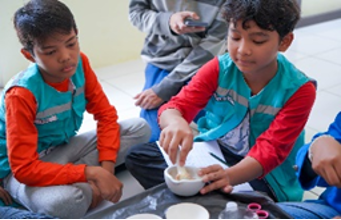Main Article Content
Abstract
Elementary school children generally start to be able to choose the foods they want. However, when selecting foods, they tend to choose visually appealing, inexpensive, and easily accessible foods without considering their nutritional content. This makes elementary school children vulnerable to health problems due to unhealthy snacks. The aim of this community service activity is to increase students' knowledge about dangerous snacks and how to detect them, provide examples of healthy alternatives from medicinal plants, and practice making food and drinks from medicinal plants. This educational activity is conducted at Athalla Cendekia Elementary School in Bogor. The method used in this community service activity is delivering materials and practicing the detection of additives such as rhodamine-b, formalin, and borax in several snack food samples around the school. Some of the snack foods tested include sausages, meatballs, sauces, fried tofu, fried meatballs, jelly, and sweetened condensed milk. Testing is carried out using reagent kits, and all 6th-grade students (25 students) are actively involved in the implementation process. Food and drink processing are conducted through direct practice in the manufacturing process and direct practice in the planting process of medicinal plants. The results of the activity show that the training proceeds attractively, with each child recording the test results in a testing booklet and being able to present the test results. Some foods tested positive for containing formalin, while some tested negative. With this education and training on detecting additives, students' knowledge increases as they can identify the types of foods containing harmful additives in the tested samples.
Keywords
Article Details

This work is licensed under a Creative Commons Attribution-NonCommercial 4.0 International License.

